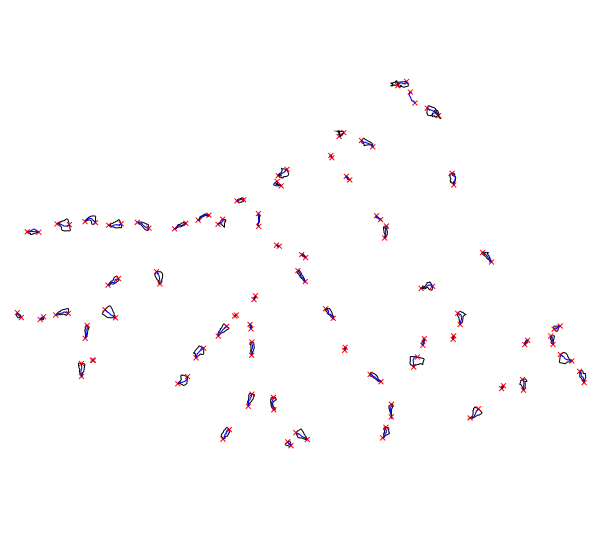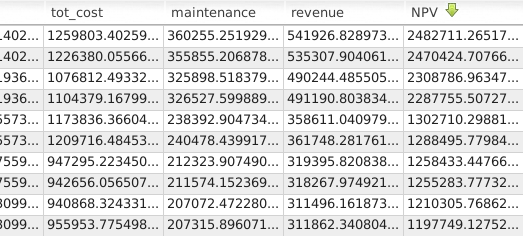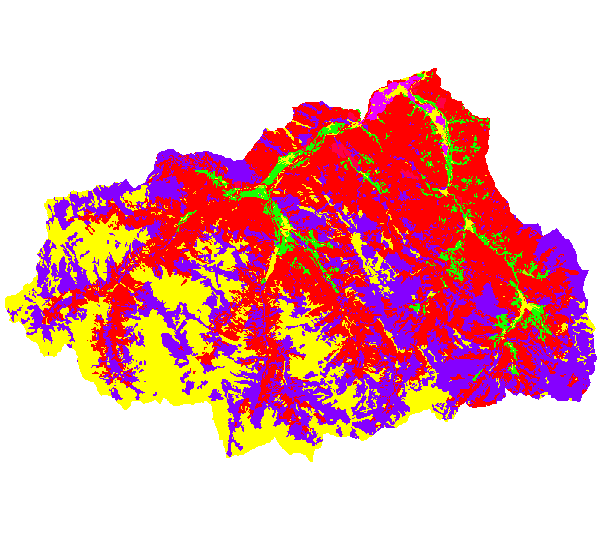This cost represents the value to compensate land owners in case of plants components implementation according to current Italian legislation. It is calculated with this formula:

where Lv is a raster map with the land use value [currency/ha];Once the calculation is made, a new column with the compensation cost is added in the table of the input map with potential plants. A raster map with the compensation cost can also be computed, as well as a raster map with the value upper part of the soil (see Optional section).
Tr is a raster map with the tributes [currency/ha];
Vu is a raster map with the value upper part of the soil [currency/ha];
r is a scalar with the interest rate (default value: 0.03);
n is the life of a hydropower plant [year] (default value: 30);
γ is a scalar (default value: 5/4);
we is a scalar with the average width excavation [m] (default value: 2);
res is a scalar with the raster resolution
The Vu raster map is computed with the formula:
where Sv is a raster map with the stumpage value [currency/ha];
Rot is a raster map with the value rotation period per land use type [year];
Y is a raster map with the average year [year]
The user can directly add the maps Lv, Tr, Sv, Rot and Y as inputs. Otherwise, the maps can be computed using the land use raster map and reclassifying the values with the module r.reclass. The program creates the reclassified maps if the user provides the input text files for each category (the input data is the path of the text file). Here is an example of a text file to create the landvalue raster map, the costs are in currency/ha:
1 = 0 rocks, macerated, glaciers 2 = 0 urbanized areas, infrastructure 3 = 0 shores 4 = 0 waters 5 = 200 gardens 6 = 4000 mining areas 7 = 2000 agricultural areas 8 = 1500 meadows 9 = 1000 areas with predominantly pastoral value 10 = 3000 forestry land
- Excavation cost:
This cost concerns the works of digging to implement channels. It is calculated as followed:

where S is a raster map with the slope in [%];If the user hasn't got the raster maps Ψ and Φ, the latter can be computed from the land use raster map if the user provides a text file with the reclassification values (from land use value to excavation cost (min or max)). It is the same principle as the one explained above for landvalue, tributes, stumpage, rotation period per land use type and average age.
Ψ is a raster map with values of minimum excavation costs [currency/mc];
Φ is a raster map with values of maximum excavation costs [currency/mc];
w is the width of the excavation [m] (default value: 2);
d is the depth of the excavation [m] (default value: 2);
l is the length of the excavation [m] which depends on the channels lengths
The user can choose to put a slope limit (Slim) [%] above which the cost will be equal to the maximum cost.
Then, a new column with the excavation cost is added in the table of the input map with potential plants. A raster map with excavation cost can also be computed (see Optional section).
- Electro-mechanical cost:
It is the cost of the electro-mechanical equipment which includes the turbine, the alternator and the regulator. It is a high percentage of a small hydropower plant budget (around 30% and 40% of the total sum).
We use the Aggidis et al. formula which calculates this cost thanks to the values of power and head:
where power is the power of the plant [kW];A new column with the electro-mechanical costs is added in the table of the input map with potential plants.
head is the head of the plant [m];
α is a power coefficient (default value: 0.56);
β is a head coefficient (default value: -0.112);
γ is a coefficient (default value: 15600);
c is a constant (default value: 0)
- Supply and installation cost for pipeline and electroline:
This is the sum of the supply and installation costs for the derivation channel, the penstock (both compose the pipeline) and the electroline which links the transformer near the turbine to the existing grid. The formula is the following:

where α is the supply and installation costs [currency/m] (default value for pipeline: 310 Euro/m, and for the electroline 250 Euro/m);- Power station cost:
l is the length of the line [m], the pipeline length is found in the structure map and the electroline length is computed thanks to the grid vector map
It concerns the construction cost of the building composing the power station. It is considered as a percentage of the electro-mechanical cost:
where α is as default 0.52
- Inlet cost:
It concerns the construction cost of the water intake structure. It is considered as a percentage of the electro-mechanical cost:
where α is as default 0.38





